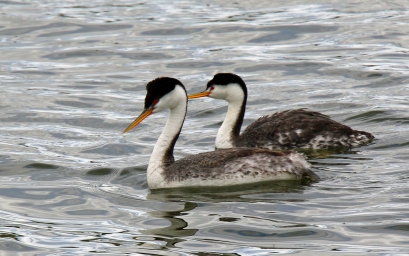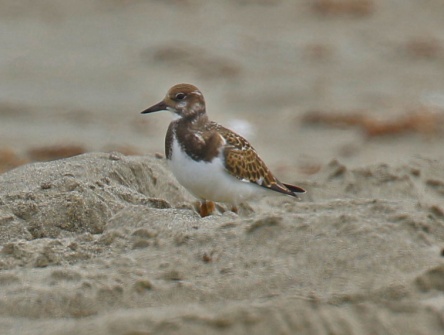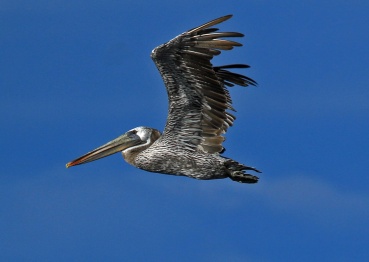Each spring and then again each fall the patterns continue: Millions of birds migrate north to breed and then return south to more hospitable winter homes and then repeat the journeys year after year. Passerines, waterfowl, raptors and gulls all participate. I pay them some attention but far less than to the shorebirds that pass through – the regular migrants and especially the rare vagrants that raise the heartbeats of all birders. I especially love August and September when shorebird migration is at its best – at times lining our shores with thousands of birds – a great variety of species and a great variety of plumages as the striking colors of the breeding season give way to the more drab colors of winter – and everything else in between as the molt continues – adding further challenges to identifying birds that are often only seen in flight, at great distance or in swirling swarms where glimpses may only be momentary.
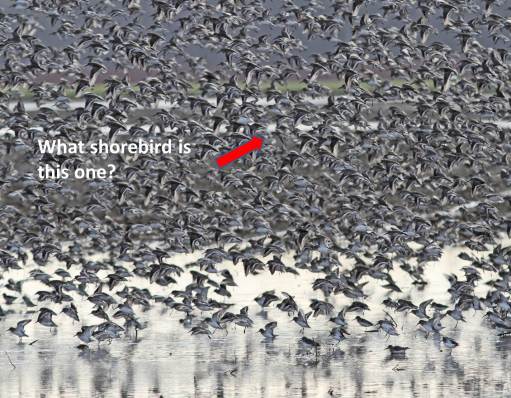
Even the plentiful “regulars” bring great joy but admittedly it is the uncommon, the unusual or even the completely unexpected rarity that is the most fun – and is what gets us out tromping into the mud of the Game Range or Bottle Beach or Eide Road or the various sewage treatment plants or drying out lakes and ponds – hoping for something special.
This August has been a good month for shorebirds and I knew I wanted to write something about them but I did not want it to be simply “I went here or there and saw this or that” although some details of my own observations were sure to find their way into the content. So with the aid of my best friend “Ebird” I decided to look into my observations more analytically and far more accurately than my memory which tends to recall the excitement without the details of place and especially time. I concentrated only on Washington observations but I did peek at my world lists to see just how significant these species have been in my birding history. Just for some context, I have seen 47 (or maybe 48 – and more of that at the end of this writing) species of shorebirds in Washington or about 11.4% of my total species seen in state and 117 shorebird species worldwide which is only about 4.4% of my total world list. While the discrepancy is due in part to the places I have birded worldwide and the times I have been there, the biggest explanation is that especially in avifauna rich areas like the forests of Central and South America and the savannahs of Africa, there is simply far more diversity of non-shorebird species.
When I started my research I expected that I would have seen more shorebird species in the Fall (which I defined as August and September) and fewer in the Spring (defined as April and May) since I thought there were more rarities (mostly with Eurasian affinities) at that time and this proved correct. Of those 47 species seen in Washington, I saw 45 in the Fall period and only 33 in the Spring. While some of this may be due to more active looking in the Fall, my experience correlated fairly closely with the general Ebird reporting for others in Washington as well. I have seen 42 (or maybe 43) species in August and 44 in September. The only shorebirds I have seen in Washington but not in August or September are Red Necked Stint and Wilson’s Plover – both one time wonders and very rare in our State.
I include pictures with dates and places for all of the shorebirds I have seen and photographed in Washington in the Fall using photos from August 2016 where I can. I do not have photos of a couple of species so may borrow from others or mine from elsewhere. Telling all the fun stories from each observation would take too long – maybe some will appear on other blog posts. Mostly this is my way of showing the diversity of our rich shorebird experience in Washington and my fun in searching for them, observing them and taking their pictures when I can – for August and September each year – A Time for Shorebirds.
The two Non-Fall Observations (but each within 10 days of August /September)
Wilson’s Plover – Midway Beach/Grayland – October 9, 2012
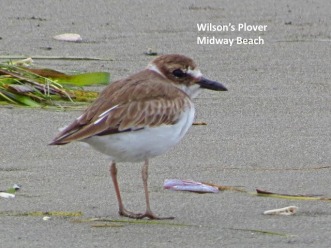
Red Necked Stint – Bottle Beach – July 22, 2013

Each year is mostly different due to when rarities show up as the core/regular and resident birds can always be seen if you go to the right place at the right time but some of the less common but yet not true rarities birds can be easily missed if you are unlucky or time a tide wrong. I would include both Golden Plovers, Red Knot (in the Fall) and maybe Red Phalarope in that latter category and might add Bar Tailed Godwit (which has become pretty regular).
Uncommon but Not Rare
American Golden Plover – Tulalip Spit – August 25, 2016

Pacific Golden Plover – Oyhut Game Range – September 13, 2011

Red Knot – Tulalip Spit August 25, 2016

Bar Tailed Godwit – Bottle Beach – August 15, 2016

Probably a notch above those species in terms of regularity or ease of finding them would be species like Stilt Sandpiper, Semipalmated Sandpiper, Wandering Tattler, Willet and Baird’s Sandpiper. They are readily found in the Fall at the right place and time but may show up as Ebird rarities depending on where they are reported. Baird’s have been particularly numerous in many places this Fall and it seems that there have been more Stilt Sandpipers this year than in the past. A Wandering Tattler was an easy and unusual find for Seattle area birders at Carkeek Park this month but are usually found only at rocky outcroppings like the jetties at Westport and Ocean Shores. Willets are regular at Tokeland but pretty hard to find anywhere else.
Less Common but Regular and Usually Found at the Right Time/Place
Stilt Sandpiper – August 24, 2014 – Eide Road

Semipalmated Sandpiper – September 2, 2014 – Eide Road

Wandering Tattler – Carkeek Park- August 22, 2016

Willet – August 10, 2016 – Tokeland

Baird’s Sandpiper – August 20, 2015 – Midway Beach

At the far end of the spectrum of rarity are the vagrants from Eurasia in addition to the aforementioned Red Necked Stint and Wilson’s Plover (not a Eurasian species) – species like Ruff, Sharp Tailed Sandpiper, Buff Breasted Sandpiper, Hudsonian Godwit (Midwestern not Eurasian) , Lesser Sand Plover and Wood Sandpiper. Some of these species are seen almost every year in Washington while some others like the Wood Sandpiper are seen maybe just once and only by a few lucky birders. I was lucky with the Wood Sandpiper found by Ryan Merrill in Skagit County in 2012 but no picture at the time. I had the good luck together with Tim Boyer to be the firsts to find the nearly full breeding plumage Lesser Sand Plover on the open beach at Ocean shores on August 16, 2015 – much more handsome than the non-breeder seen at Oyhut on September 1, 2013.
Real Rarities
Ruffs – September 3, 2014 and September 14, 2015 – Oyhut Game Range

Sharp Tailed Sandpiper (with Pectoral Sandpiper) – Eide Road – September 11, 2012

Buff Breasted Sandpiper – September 7, 2013 – Grayland Beach State Park

Hudsonian Godwit – September 29, 2015 – Ilwaco

Lesser Sand Plover – August 16, 2015 -Ocean Shores

Although most of the shorebirds in Washington can be found in Western Washington, two beauties are in Eastern Washington almost exclusively – and are major news if on the West side. These are the Black Necked Stilts and American Avocets that are found in ponds and Sewage Treatment Plants generally east of the Columbia River. Other birds are with them but these really jump out. Often these same ponds also have Wilson’s (breeding) and Red Necked (in migration) Phalaropes. Both of these can be found in Western Washington but more rarely – except on pelagic trips on the Pacific where Red Necked Phalaropes are plentiful in migration and are joined by the much rarer Red Phalaropes – but do appear in Eastern Washington rarely as well.
Eastern Washington Species
Black Necked Stilt – August 13, 2014 – Winchester Wasteway Ponds

American Avocet – August 13, 2014 – Winchester Wasteway Ponds

Red Necked Phalarope – August 12, 2016 – Para/McCain’s Ponds

Wilson’s Phalarope with Yellowlegs – September 15, 2015 – Soap Lake

Red Phalarope – August 28, 2016 -Pelagic Species on Pacific and sometimes in Eastern Washington

Shorebirds come in all sizes ranging from the smallest “peeps” like the Western, Least and Semipalmated Sandpipers to the largest like the Greater Yellowlegs, Godwits, Whimbrel and Long Billed Curlew. In between in addition to many already mentioned are species like the Wilson’s Snipe, Spotted and Solitary Sandpipers, Dunlin, Lesser Yellowlegs, Long Billed and Short Billed Dowitchers, Sanderlings and the common Plovers – Black Bellied, Semipalmated and Killdeer. All are regular, widespread and common in season. The Snowy Plover also belongs in this group but is endangered and limited to a few areas of open beach…regular but can be hard to find.
The “Peeps”
Western Sandpiper – August 21, 2011

Least Sandpiper – August 10, 2016 – Tokeland
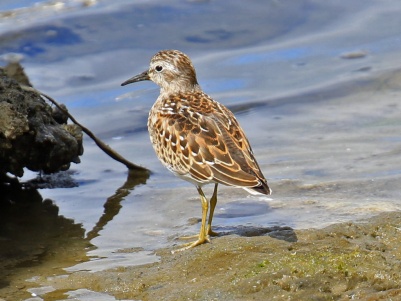
Semipalmated Sandpiper (pictured earlier above)
Other More Common Shorebirds
Wilson’s Snipe – August 27, 2014 – Ridgefield NWR

Greater and Lesser Yellowlegs – August 5, 2015 – Eide Road

Marbled Godwit (Top Left) and Whimbrel (Lower Right) with Willets – August 20, 2016 – Tokeland

Long Billed Curlew – September 4, 2015 – Bottle Beach

Spotted Sandpiper Juvenile – September 10, 2015 – Neah Bay

Solitary Sandpiper – August 26, 2016 – Wiley Slough

Dunlin – September 14, 2015 – Oyhut Game Range

Long Billed Dowitcher – August 1, 2014 – Wylie Slough (More common inland)
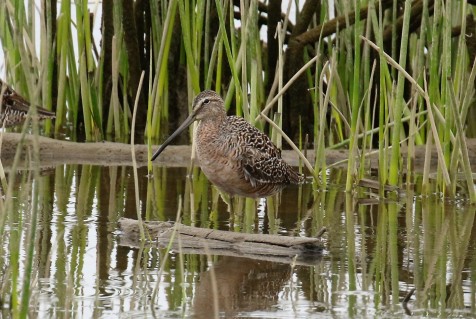
Short Billed Dowitcher – August 27, 2016 – Bottle Beach (more common on the coast)

Sanderling – August 10, 2016 – Open Beach Midway

Black Bellied Plover – August 15, 2016 – Bottle Beach

Semipalmated Plover – August 15, 2016 – Bottle Beach

Snowy Plover – Grayland/Midway Beach

Killdeer – August 16, 2015 – Oyhut Game Range

Another grouping of shorebirds that are regularly seen in August and September are the so-called “Rock Pipers“. These birds are usually found along rocky shores or on log booms in salt water. They include the Wandering Tattler already pictured above and Surfbirds, and both Black and Ruddy Turnstones. Rock Sandpipers are in this group and usually come later although I do have a single September record. I am also including the striking and much larger Black Oystercatcher – not really a Rock Piper – but generally found on rocky shores.
The “Rock Pipers”
Black Turnstone – August 27, 2016 – Point Brown Jetty

Ruddy Turnstone – August 27, 2016 – Point Brown Jetty

Surfbird – August 20, 2011 – Three Crabs – Sequim

Rock Sandpiper – No photo from August or September so I am using one from February 2014 – from the Point Brown Jetty (but I saw one at the same location last year on September 14)

Black Oystercatchers – September 10, 2015 – Neah Bay

There are two more species of shorebird that I have seen in Washington in August or September but sadly have no pictures of them from the state. One is the Upland Sandpiper which I saw with Dennis Paulson as a flyover on the Oyhut Game Range on September 6, 2013. I include a picture I took of one at the Kennebunk Plains in Maine in June 2015. The other is the aforementioned Wood Sandpiper – a “mega” rarity that is common in Africa and Asia and quite a find as a vagrant in far western Alaska. One was seen on Adak the week I visited this spring but sadly I was not able to see it and take a photo so the picture is from my South Africa visit in 2014.
Missing Photos from Washington – Two Rarities
Upland Sandpiper – Photo from my Maine Trip – June 20, 2015 – Kennebunk Plains

Wood Sandpiper – October 15, 2014 – My South Africa Trip
And ah, yes there is one more – well maybe there is and maybe there is not. Here is the story: On August 2, 2012 I was birding on the coast and in the morning drove the open beach near Midway – a favorite place and one that is the location for some of the photos above. I was primarily looking for Snowy Plovers which I did not find that day. However, there were many birds on the beach including a larger than usual number of Whimbrels (12) and many of the more common birds like Semipalmated Plovers and Western Sandpipers and Sanderlings. I met a woman who worked for the Washington Department of Fish and Wildlife and we chatted for a while next to some logs on the upper beach. She monitored the Snowy Plovers in the area (their breeding area in the dunes is roped off and protected) and we had a fascinating chat.
We casually paid attention to the shorebirds along the surf but my focus was on her Snowy Plover wisdom. Suddenly all hell broke loose and all of the birds nearby took off. This is usually initiated by a Peregrine Falcon flying by. This time there was no falcon but a Parasitic Jaeger, another bird that preys on small shorebirds, flew past – the danger that set the birds to flight. Although it was admittedly a fleeting view, we clearly noted that one of the birds in the groups was “different”. Not all field marks were processsed but this one bird was notably larger than the Western Sandpipers and had what appeared to be a gray back and MOST importantly a WHITE RUMP. At the time I had no idea what it was or could be or what else to look for but that white rump was unmistakable and the size was noticeably if not significantly larger than the Western Sandpipers that flew off with it – but without the white rumps.
I submitted it as a White Rumped Sandpiper on Ebird and not surprisingly it was rejected as insufficient description and of course no photo. I would like to think that if the same thing happened today I would be more attuned to details and I most likely would have a photograph as I have learned how they are not just records that I can enjoy over and over and share but also can be used to identify a bird and often to change an initial impression to something else when the captured field marks can be more closely examined. So what was that bird? Sure it is possible that the rump may have appeared more white than it actually was – but it was an overwhelming detail as it flew – as distinctive as the wing pattern of a Willet in flight for example – it just jumps out at you. If indeed that rump was white as “observed” then the only two possibilities are White Rumped Sandpiper and Curlew Sandpiper. Either is incredibly rare in Washington.
Since that time I have had the opportunity to observe a Curlew Sandpiper in South Africa. The gray back and white rump certainly match my memory but I would like to think I would have seen and noted the clearly curved and longer bill. So maybe I did and maybe I didn’t see a White Rumped Sandpiper or even a sandpiper with a white rump that day now more than 4 years ago. Tell you one thing – if there is a next time, the camera will be ready.
Sandpipers with White Rumps
White Rumped Sandpiper (Photo by Mike Fahay)

Curlew Sandpiper – October 7, 2014 – My South Africa Trip

So there it is – the wondrous migration of shorebirds in August and September – all 48 (or 47) of the ones I have been fortunate to see. This August has been a pretty good month for shorebirds already as well – 35 species seen. As stated above, there seem to have been more Stilt Sandpipers and Baird’s Sandpipers reported from all over the state than I can remember in past years. I have seen 13 different Baird’s Sandpipers in 6 different locations and at least 5 different Stilt Sandpipers in 3 different locations. I know of other observations of both species elsewhere. So far no Ruffs or Buff Breasted Sandpipers and no Hudsonian Godwits or Sharp Tailed Sandpipers. An early Rock Sandpiper was reported from the jetties at both Ocean Shores and Westport, but I was unable to find it. And too many people were on Midway Beach when I was there so no Snowy Plover either although I saw and photographed some in the Spring. But September will be here in another two days – and hopefully all of these little beauties will appear and be enjoyed. Maybe something really special will come in as well. I am thinking a Terek Sandpiper would be really nice.
Terek Sandpiper – Someday if I Am REALLY LUCKY!!

Don’t get stuck in the mud!!
August 31, 2016 – Addition to the Blog Post
An addition to this blog – I almost went up to Vancouver, B.C. today – encouraged by Melissa Hafting – a wonderful birding friend and resource who was on my recent pelagic trip. Melissa knows more about what is going on with birds in B.C. than anyone – and frankly often knows about our Washington bird reports before I do – and she shares all of this information openly. She told me of 4 Buff Breasted Sandpipers and a Ruff that were being seen regularly at Boundary Bay – a wonderful birding spot across the border. Her pictures are included below – so gorgeous as are all of her photos. I just could not get it together to make the trip today (August 31). It would be great to see the birds and get photos and add to my August 2016 Shorebird Species list – BUT – not in Washington even if close and besides she just sent me a note that it is raining there. May not affect the birds but it does affect the birding. But the photos are so nice I thought I would make this addition – and thank Melissa for all of her help and support.
Ruff – Boundary Bay B.C. – Photo by Melissa Hafting

Buff Breasted Sandpiper – Boundary Bay B.C. – Photo by Melissa Hafting

Guess its A Time for Shorebirds in B.C. as well. Hope these guys head south for a stop soon!!


















